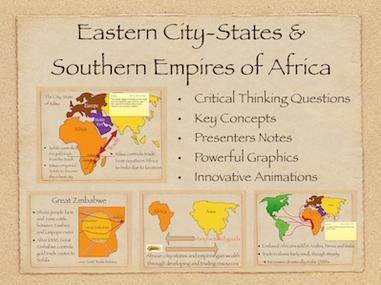EASTERN CITY STATES AND SOUTHERN EMPIRES OF AFRICA
HISTORY PRESENTATIONS
ENGAGING HISTORY POWER POINTS
Mr. Harms has designed a number of Power Point and Keynote presentations Social Studies Concepts and Critical Thinking Questions to help students understand history. Designed by a teacher for teachers, this Power Point focuses on "Eastern City States and Southern Empires of Africa".
Overview
These history presentations are designed to give students an overview of how Eastern City States and Southern Empires of Africa developed. Students will be shown maps, animations and descriptions detailing these events.
Customizable
The presentation is totally customizable, allowing you to add your own pictures, graphics and animations to take what we've done even farther.
Benefit
What is your time worth? Our basic pricing system for History Presentations is 10 cents per slide. Some title slides may only take 30 seconds to create, but complex slides with animations and coordinated builds for complicated topics may take 30 minutes or more. It's not unusual for a presentation to take between 3 and 7 hours of work. What could you do with 6 or 7 free hours?
Topics Included
Topics include: East African Trade, Islamic Influence, Aksum, Bantu, Kilwa, Natural Resources, religion, Slave Trade, Great Zimbabwe, Mutapa Empire, Imperialism.
Included in The Presentation Package:
1. Keynote Presentation
2. Power Point Presentation
3. Text edit file outline of the presentation and presenter's notes.
The package is a digital download (Zip File) of these three items.
Click The Link Below To Get Your Copy
Source:
MCDOUGAL LITTEL'S WORLD HISTORY: PATTERNS OF INTERACTION
Unit 3 An Age of Exchange and Encounter
Chapter 15 Societies and Empires of Africa
Section 3 "Eastern City States and Southern Empires"
Module 12 Societies and Empires in Africa
Lesson 5 Eastern City States and Southern Empires
These materials were prepared by Harms LLC and have neither been developed, reviewed, nor endorsed by Houghton Mifflin Harcourt Publishing Company, publisher of the original WORLD HISTORY: Patterns of Interaction work on which this material is based.
Video Preview
Related History Presentations
- Societies and Empires of Africa 1500 BC To 1500 AD
- Diverse Societies In Africa
- North and West African Civilizations
- Eastern City-States and Southern Empires

